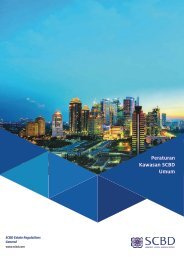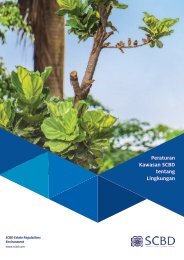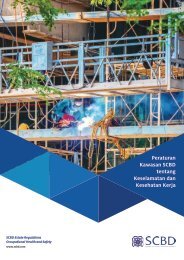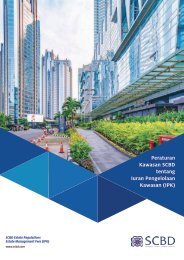SCBD_Buku Pedoman Pelaksanaan Keselamatan dan Kesehatan Kerja_BP2K3_LR.compressed
You also want an ePaper? Increase the reach of your titles
YUMPU automatically turns print PDFs into web optimized ePapers that Google loves.
3. Di dalam kabin hidupkan alat-alat <strong>dan</strong> laksanakan uji kerja/fungsi dari peralatan<br />
(troli, pengait, pemutar, kecepatan, dll.).<br />
In the cabin, turn on the devices and test the performance/function of the equipment<br />
(trolleys, hook, swing, speed, etc.).<br />
4. Lakukan pemeriksaan komunikasi radio dengan juru ikat/petugas sinyal <strong>dan</strong><br />
Informasikan kepada juru ikat/petugas sinyal bahwa alat siap operasi.<br />
Test radio communication with the rigger/signalman and inform the rigger/signalman<br />
that the equipment is ready for operation.<br />
5. Tidak diizinkan orang lain (selain operator) ada di atas kran menara.<br />
No other person (besides the operator) is permitted to be on the TC.<br />
H PENGOPERASIAN ALAT<br />
EQUIPMENT OPERATION<br />
1. Operator kran menara, juru ikat, <strong>dan</strong> supervisor, selalu memperhatikan sifat <strong>dan</strong><br />
bentuk material yang akan diangkat (kotak, plat, batang, <strong>dan</strong> cairan).<br />
TC operator, rigger, and supervisor must always consider the nature and shape of the<br />
material which is to be lifted (box, plate, tube, and liquid).<br />
2. Semua gerakan dicoba dengan pelan <strong>dan</strong> selanjutnya kecepatan tidak berlebihan.<br />
All movements must be tested slowly and subsequently made at the proper speed.<br />
3. Selalu perhatikan radius beban, kondisi di area bawah beban, dll.<br />
Always consider the load radius, the condition of the area under the load, etc.<br />
4. Jika ada 2 kran menara atau lebih, yakinkan ruang bebas sebelum putaran atau<br />
pastikan anti tabrakan berfungsi.<br />
If there are 2 TCs or more, ensure the availability of space before slewing or ensure that<br />
the anti collision functions properly.<br />
5. Tidak menarik beban dari samping, pastikan material yang diangkat pada titik tengah<br />
<strong>dan</strong> diangkat lurus.<br />
Do not pull the load from the side, ensure that the material is lifted from the center in a<br />
linear trajectory.<br />
6. Arahkan lengan searah rel jika melakukan penjalan.<br />
Direct the jib along the rail when traveling.<br />
7. Pahami instruksi dari juru ikat sebelum bertindak.<br />
Understand the instruction of the rigger before taking action.<br />
8. Pastikan juru ikat menghidupkan sirine sebelum <strong>dan</strong> selama pengangkatan<br />
dilakukan.<br />
Ensure that the rigger turns on the siren before and during lifting.<br />
9. Hentikan operasi kran menara bila kondisi cuaca buruk/hujan atau kecepatan angin<br />
40 km/h atau 11,11 m/s (24,85 mph) berdasarkan anemometer.<br />
Stop the TC operation in bad weather/rain or at a wind velocity of 40 km/h or 11.11 m/s<br />
(24.85 mph) based on the anemometer.<br />
I PENGIKATAN DAN PENGANGKATAN<br />
RIGGING AND LIFTING<br />
1. Lokasi pengangkatan material harus ditentukan, tidak boleh pengangkatan<br />
dilakukan dari sembarang area.<br />
The location of material lifting must be determined, lifting is not allowed to be carried out<br />
in unauthorized locations.<br />
2. Pengikatan material ke kran menara harus dilakukan oleh juru ikat atau di bawah<br />
pengawasan juru ikat, semua material harus terpasang tali.<br />
Materials must be tied to the TC by a rigger or under the supervision of a rigger, all<br />
materials must be equipped with a driving rope.<br />
3. Titik pengangkatan harus lurus, tidak boleh menyamping atau menyeret material.<br />
Lifting must be carried out upright instead of sideways and do not drag the material.<br />
Occoupational Health and Safety Guidebook 35








